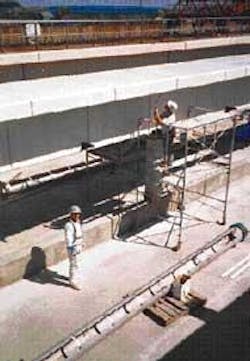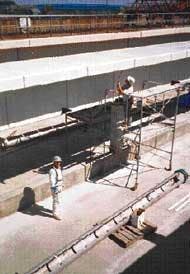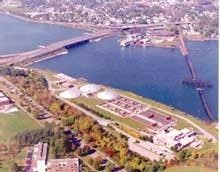New Coating System Joins War Against Corrosion
By Lake H. Barrett, Jr.
Corrosion is a pervasive problem that has contributed significantly to the decline of water and wastewater infrastructure in the United States. The Water Infrastructure Network (a conglomeration of water and wastewater organizations) estimates that in order to fix America's aging infrastructure, the industry will have to invest at least $23 billion annually on existing water and wastewater facilities for the next 20 years.
Historically, all collection pipes, clarifiers, rake arms, grit chambers and troughs were coated with coal tar epoxy and thin film (roughly 12 mils) polyamide coatings. Often times, submerged surfaces of concrete were not coated at all.
The Tnemec Co., a coatings manufacturer, has been exploring ways to combat corrosion. When designing a new coating system, the company's research and development department set out to create a high-performance lining system specifically for aggressive wastewater conditions. The result was a two-component hybrid polymer mortar developed to deliver excellent chemical resistance. Often called thick film, it is 10 times thicker (125 mils versus the 12 mils of thin film) and provides long-lasting protection in hydrogen sulfide gas and sulfuric acid solutions.
Portland Project
In April 2000, the Portland, ME, City Council responded to citizen complaints by voting to approve a $5.3 million odor control project at the East End Wastewater Treatment Facility. A few months later, local Tnemec coatings consultant Don Miller of The Righter Group, Wilmington, MA, received a call from Chris Dwinal, senior project engineer for the Topsham, ME, engineering firm of Wright-Pierce.
Wright-Pierce had been retained by the Portland Water District (PWD) to provide a preliminary design for the project, focusing on odor control technology, ventilation rates, a tank cover system, a hydrogen resistant tank coating system and cost estimates. Chartered by the state of Maine in 1908, PWD, in addition to its role as the regional water supplier, serves more than 190,000 people in 11 greater Portland area communities. PWD wastewater treatment customers number 24,595.
Serving the city of Portland, the East End Wastewater Treatment Facility was constructed in 1976 as a secondary treatment plant. It has 700 feet of 7 ft. x 8 ft. concrete channels, three sedimentation tanks 200 feet long x 50 feet wide x 12 feet deep, six aeration tanks, three clarifiers, and two chlorine contact tanks. Wastewater treated in this facility flows into Casco Bay at a purification level of 90 percent.
Working closely with Dwinal and PWD Chief Engineer Scott Firmin, Miller saw this project as a perfect application for Tnemec's high-performance lining system, the Series 434 ChemBloc H2S coating. Designed to be an easier product to control, it is less hazardous to work with and easier to store than vinyl ester.
The odor control improvement process began in September 2001. Because the East End facility's daily volume of 20 million plus gallons demanded the capacity of at least two tanks, Miller and applicator Mark McPheters, vice president of T. Buck Construction, Auburn, ME, – through Buck's painting subsidiary Blue Finn – went to work on the first of three tanks.
McPheters and his crew sandblasted and power-washed the first tank, all tunnels under the building and the more than 700 feet of open air concrete channels.
After determining that only five percent of the 40,000-square-foot concrete surface needed repair, the Blue Finn crews patched the cracks, "holidays" and all deep holes. Because this work occurred during the winter, a temporary wood truss roof was built and forced hot air was inserted to achieve a suitable working environment.
Using a powerful, pressure piston pump, the crews applied the cream-colored polymer lining, which was then immediately troweled to a smooth finish. For the sedimentation tanks, the polymer coating was applied down two feet under the water line.
With two of the three tanks now coated, the entire operation is scheduled for a completion date of June 2003. Custom aluminum covers over the tanks and channels also will be installed in the spring of 2003.
The odor control system will include a 53,000-cfm, two-stage wet chemical scrubbing system covering three plant influent channels, two grit chambers, flow splitting structure, primary sedimentation basin influent channels, three primary sedimentation basins, and two gravity thickeners. This process is the finest air quality treatment available, and is used by only a handful of New England wastewater treatment plants.
Battling MIC
Ever since the Clean Water Act of 1972 demanded wastewater treatment facilities upgrade from a primary treatment obligation to secondary treatment in order to obtain EPA licensing, more and more businesses and citizens are demanding odor controls. With odor control emission standards currently in their infancy, it is estimated that only a small percentage of all plants today have odor control systems in place.
Any municipality contemplating odor control will require concrete protection against corrosion caused by two common enemies: hydrogen sulfide gas (H2S) and sulfuric acid. These two by-products of bacteria contribute to micro-biologically induced corrosion (MIC).
Collection systems with low velocities encourage the growth of anaerobic bacteria. These bacteria produce sulfides, which when combined with hydrogen, create the "rotten egg" odor often present in sewer systems.
Add a damp surface above the water line to this gas and it produces sulfuric acid which attacks, corrodes and breaks down concrete. The sealing of tanks and distribution channels to contain the offensive odor creates a highly aggressive atmosphere for the concrete surfaces. It is this common occurrence in all wastewater systems that led to the development of Tnemec's new lining system.
Aggressive corrosion, exacerbated by odor control structures similar to those found in Portland, is challenging coating manufacturers to create more durable linings and coatings. As the need to combat corrosion grows throughout the United States, it becomes more important for wastewater treatment plants to select the proper coating systems to protect their facilities from the ravages of hydrogen sulfide gas, sulfuric acid and MIC. WW/
About the Author: Lake H. Barrett Jr. is the director of water and wastewater operations for Tnemec. A corrosion and wastewater industry veteran, Barrett holds a bachelor's degree in mechanical engineering from Penn State University, State College, PA, and is pursuing a master's degree in management. He is an active member of SSPC, NACE, ASME, AWWA and WEF.


